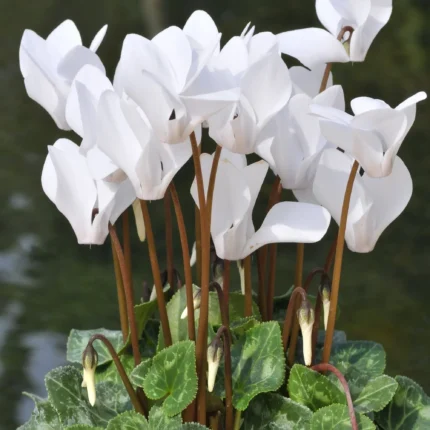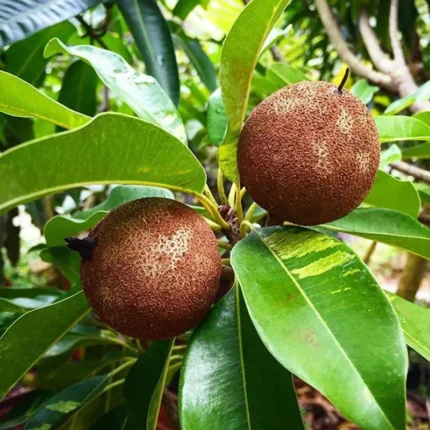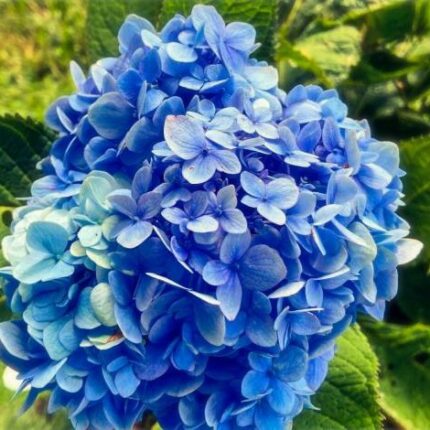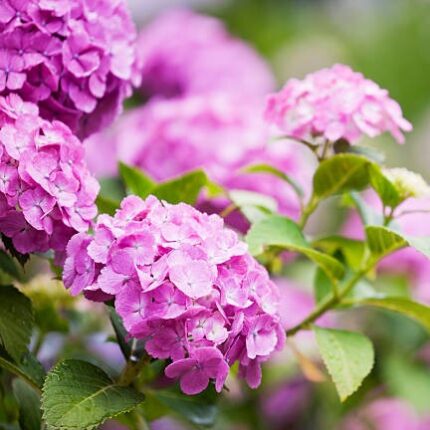Maintaining hydrangeas involves a combination of care practices to ensure healthy growth, abundant blooms, and an overall attractive appearance. Here’s a guide to hydrangea maintenance:
- Watering: Keep the soil consistently moist, especially during dry periods. Water deeply to encourage deep root growth. Avoid waterlogged conditions, as hydrangeas are susceptible to root rot. Mulching around the base helps retain soil moisture.
- Soil: Hydrangeas prefer well-draining soil rich in organic matter. Amend the soil with compost or well-rotted manure to improve fertility and structure. Soil pH can affect flower color in some varieties, so consider testing and adjusting it if desired.
- Fertilization: Feed hydrangeas with a balanced, slow-release fertilizer in early spring or late winter before new growth begins. Avoid excessive use of high-nitrogen fertilizers, as this can promote lush foliage at the expense of flowers.
- Pruning: Pruning requirements depend on the type of hydrangea:
- Bigleaf Hydrangeas (e.g., Hydrangea macrophylla): Prune after flowering, cutting back old wood to shape the plant and encourage new growth.
- Panicle and Smooth Hydrangeas (e.g., Hydrangea paniculata, Hydrangea arborescens): Prune in late winter or early spring before new growth emerges. Remove dead or weak stems to promote a healthier structure.
- Deadheading: Remove spent flowers to encourage continuous blooming. This is particularly important for varieties that bloom on new wood.
- Winter Protection: In colder climates, protect hydrangeas from harsh winter conditions by applying a layer of mulch around the base. Avoid heavy pruning in fall, as this can remove protective growth.
- Sunlight: Ensure hydrangeas receive the appropriate amount of sunlight based on the variety. Most hydrangeas prefer partial shade or filtered sunlight, especially in the afternoon.
- Pest Control: Keep an eye out for common pests such as aphids, scale insects, and spider mites. Treat infestations promptly with insecticidal soap or neem oil.
- Disease Prevention: Provide good air circulation by spacing plants properly and pruning when needed. Water at the base of the plant to keep foliage dry and reduce the risk of fungal diseases.
- Container Care: If growing hydrangeas in containers, use a well-draining potting mix, and ensure containers have drainage holes. Watering needs may be higher for container-grown hydrangeas, so monitor soil moisture regularly.
- Adjustments for Flower Color: For certain hydrangea varieties with pH-dependent flower color changes (e.g., blue or pink blooms), you can adjust soil pH using amendments such as aluminum sulfate for acidic conditions or lime for alkaline conditions.
By following these maintenance practices, you can enjoy healthy, vibrant hydrangeas in your garden. Tailor your care routine to the specific needs of the hydrangea variety you have, and you’ll be rewarded with beautiful blooms season after season.





















Kanav Choudhury –
Honestly a great experience with the vibrant and healthy plants. Highly recommended! Superb experience with Royals Plant.
Krish Sidhu –
Exceeded my expectations in the customer service and plant quality. Highly recommended! Thank you Royals Plant!
Advika Savant –
Exceeded my expectations in the vibrant and healthy plants. Thanks a lot!
Chirag Gola –
Really impressed with the customer service and plant quality. Such a pleasant experience. Ordering again from Royals Plant.
Nehmat Bhatt –
Really impressed with how fresh the plants arrived. Really appreciate the care. Royals Plant never disappoints.
Ryan Apte –
Truly amazed by the packaging and timely delivery. Keep up the good work! Ordering again from Royals Plant.
Vedika Verma –
Absolutely loved the smooth order process. Such a pleasant experience. Ordering again from Royals Plant.
Kismat Baria –
Loved the how fresh the plants arrived. Highly recommended! Great job, Royals Plant.
Suchismita Mukherjee –
My plant arrived full and healthy. It made a perfect gift and is flourishing wonderfully. The packaging was very secure, with protective layering to prevent any damage during shipping.
Rajat Guha –
Absolutely loved the quality of the plant. It was vibrant, healthy, and looked even better than the pictures online. Superb packaging! The plant was cushioned well and looked like it was just picked fresh.
Tanaya Mitra –
Great value for the price. The plant was lush, green, and clearly handled with care. Superb packaging! The plant was cushioned well and looked like it was just picked fresh.
Ojas Ahuja –
Loved the plant, very healthy.
Diya Amble –
Arrived safely and was well packed.
Lagan Arya –
Perfect for my balcony, good job!
Arhaan Balasubramanian –
Value for money, plant was in great condition.
Damini Thaker –
Good quality, on-time delivery.
Kiaan Datta –
Value for money, plant was in great condition.
Armaan Choudhry –
Satisfied with the plant, looks great.
Lakshit Datta –
Value for money, plant was in great condition.
Rupsha Dutta –
The plant arrived in excellent condition, with lush green leaves and a strong stem. Really impressed by the freshness. Very secure packaging, and even the box smelled fresh when I opened it.
Farhan Verma –
Unboxing the plants was such a delight. Everything looked exactly like the pictures. Healthy leaves, strong stems, and no damage during transit whatsoever.
Baiju Sani –
I had ordered three different types of plants, and all of them arrived in excellent shape. The soil was moist and the pots were very sturdy. Really impressed.
Siya Din –
The variety of plants available is amazing. I received my order on time, and the plants were lush and green. It added so much life to my living room!
Shlok Butala –
Royals Plant never fails to impress me! The packaging, freshness, and delivery speed were spot on. Thank you for helping me build a beautiful green space at home.
Samarth Maharaj –
Received my fourth order from Royals Plant and once again, it exceeded expectations. Thank you for keeping up the consistency and quality every time.
Indranil Mammen –
I had ordered three different types of plants, and all of them arrived in excellent shape. The soil was moist and the pots were very sturdy. Really impressed.
Amira Desai –
I love how neatly everything was packed. All the plants arrived in perfect condition and are growing really well. Excellent quality and care taken with each one.
Rania Chopra –
I love how neatly everything was packed. All the plants arrived in perfect condition and are growing really well. Excellent quality and care taken with each one.
Vivaan Desai –
The variety of plants available is amazing. I received my order on time, and the plants were lush and green. It added so much life to my living room!
Sahil Chakraborty –
I had ordered three different types of plants, and all of them arrived in excellent shape. The soil was moist and the pots were very sturdy. Really impressed.
Raunak Mandal –
Beautiful, fresh, and well-maintained plants. The attention to detail in packaging was noticeable and appreciated. My entire indoor setup now looks so much better.
Shalv Mand –
Unboxing the plants was such a delight. Everything looked exactly like the pictures. Healthy leaves, strong stems, and no damage during transit whatsoever.
Anya Bava –
Unboxing the plants was such a delight. Everything looked exactly like the pictures. Healthy leaves, strong stems, and no damage during transit whatsoever.
Dhanush Chandran –
Affordable and premium quality plants.
Romil Grover –
The variety of plants available is amazing. I received my order on time, and the plants were lush and green. It added so much life to my living room!
Prerak Sachdeva –
Loved the variety and freshness of the plants received.
Advik Deo –
Unboxing the plants was such a delight. Everything looked exactly like the pictures. Healthy leaves, strong stems, and no damage during transit whatsoever.
Dhanush Issac –
Great experience ordering online, will come back again.
Tara Balasubramanian –
Very impressed with the packaging and plant quality.
Drishya Sheth –
Everything was well packed and delivered safely.
Biju Ramesh –
The quality exceeded my expectations.
Divit Shetty –
Really happy with Royals Plant’s quality and fast delivery.
Divyansh Gulati –
Very impressed with the packaging and plant quality.
Oorja Dugar –
Arrived on time and all the plants were in excellent condition.
Umang Gole –
Arrived on time and all the plants were in excellent condition.
Mamooty Tella –
Everything was well packed and delivered safely.
Vaibhav Das –
Affordable and premium quality plants.
Zaina Joshi –
Excellent service and beautiful plants.
Farhan Borah –
Excellent service and beautiful plants.
Dhanush Dasgupta –
Really happy with Royals Plant’s quality and fast delivery.